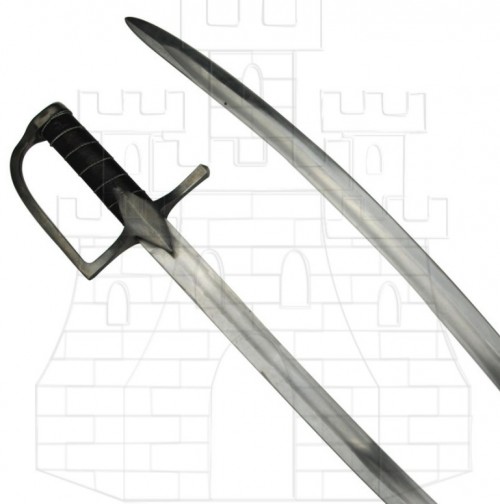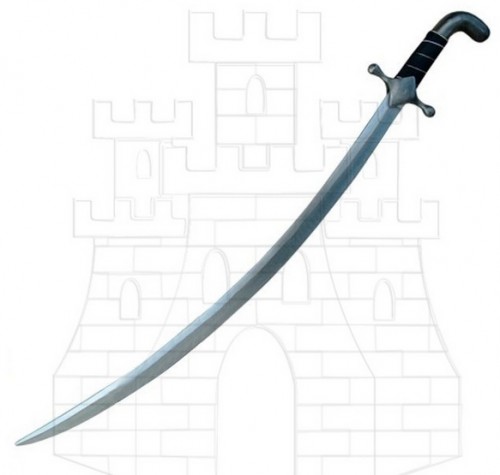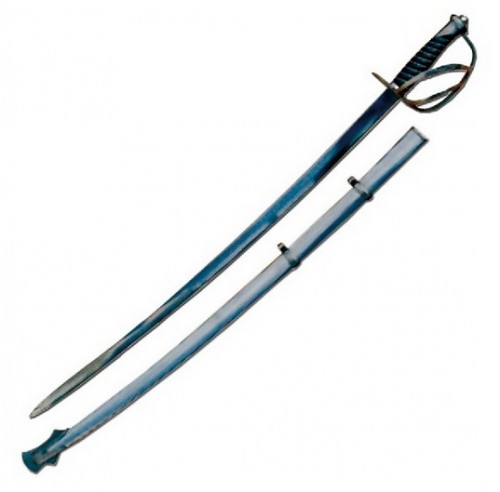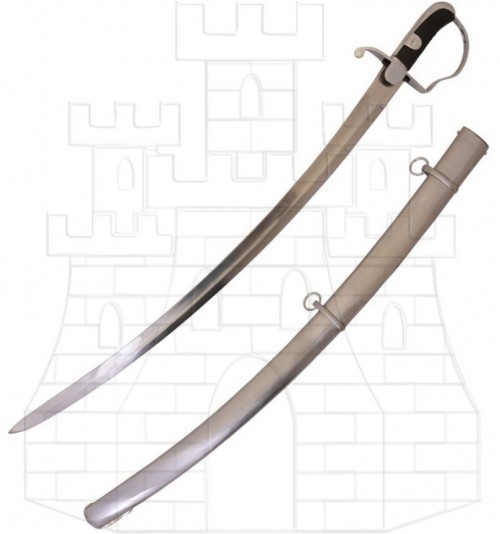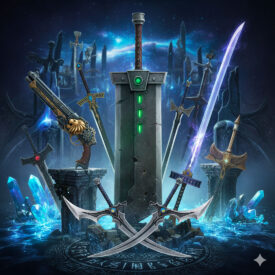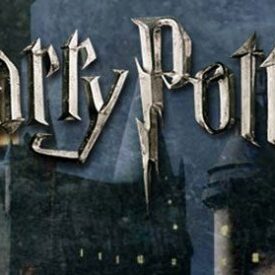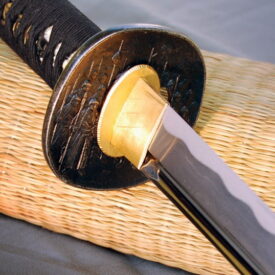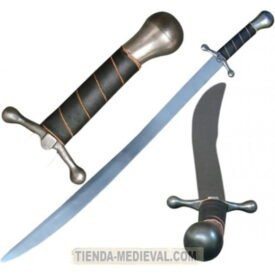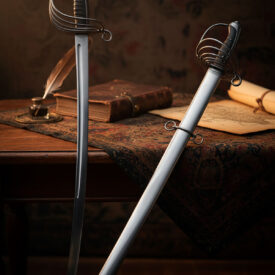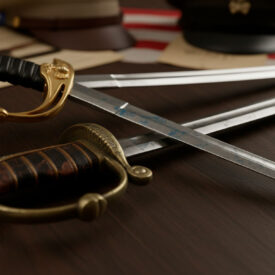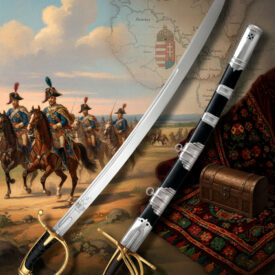The Cavalry Saber: A Curved Legend on the Battlefield
The cavalry saber is not just a weapon: it is a symbol of honor, skill, and tactical adaptation. Its curved blade and single edge marked a revolution in mounted combat and defined the image of the horseman in numerous armies. In this article, you will learn about its history, anatomy, its role in different eras, and how to identify and preserve replicas or historical pieces.
Origins and Spread: From the Steppes to Europe
The first antecedents of curved blades appear in antiquity, but the saber as we know it was perfected in the Eurasian steppes. Nomadic peoples such as the Scythians, Huns, Mongols, and Turks developed techniques and designs oriented towards mounted combat and cavalry charges, where the horse’s speed multiplied the cutting power of the curved blade.
With migrations and conquests—and later with the influence of the Ottoman Empire—the saber infiltrated Asia Minor, North Africa, and finally Western Europe starting in the 16th century. Light forces such as the Hungarian hussars and the Polish-Lithuanian winged hussars played a crucial role in its dissemination.
Anatomy and Design: The Perfection of the Curve
Each part of the saber responds to the need to optimize combat on horseback. The blade has a curvature that varies according to tradition: very curved in oriental models for powerful cuts; moderately curved in European models to combine cutting and thrusting. The typical length ranged from 80 to 90 centimeters, enough to reach the enemy without interfering with riding.
The hilt is ergonomic and secure, often curved and designed to remain stable during the gallop. The guards in the form of a cup, basket, or stirrup protect the rider’s hand and allow for a firmer grip. Materials such as wood, leather, ivory or mother-of-pearl, and brass or iron fittings completed the ensemble.
Function and Tactics: Why the Curve Conquered the Field
The saber’s design responds to a technical need: to maximize cutting and maneuverability from a moving horse. The curvature allows the edge to slide over the target instead of getting stuck, producing longer wounds and keeping the weapon free for the next blow.
- Greater cutting capacity: the blade’s geometry increases the effective energy of the blow during the charge.
- Better control: circular movements and techniques such as the mill stroke are natural with a curved blade.
- Reduced risk of jamming: curved blades tend to exit the body more easily than straight ones.
These advantages were not absolute: sabers were less effective for thrusting and less appropriate against heavy armor. Therefore, in some corps, straight swords or hybrid variants that combined curvature and thrusting capability continued to be used.
Evolution through Eras: How the Saber Changed with Warfare
The form and function of the saber evolved with warfare and technology. During the Renaissance and the Thirty Years’ War, it began to replace the straight sword among light cavalry. In the Napoleonic Wars, the saber became lighter and more balanced, exemplified by models such as the French An XI. In the 19th century, colonial wars required robust and reliable sabers, while World War I ended classical cavalry’s dominance against artillery and machine guns.
Diversity of Sabers: Adaptations by Unit and Nation
There is no single cavalry saber. The differences respond to doctrines, terrain, and tradition. Hussars and Uhlans preferred light and very curved blades; heavy cavalry needed wider and less curved blades to break formations. Nationally, France projected elegance and balance, Prussia robustness and functionality, and Spain maintained a notable forging tradition in Toledo.
Shorter naval variants for combat on deck also emerged, and richly ornamented officer versions for ceremonial functions. The saber as a social and military distinctive persists in uniforms and parades.
Legacy and Tradition of the Cavalry Saber
Although today the saber is no longer an active weapon of war, its cultural and symbolic legacy is undeniable. It remains present in military ceremonies, in collections, and in the practice of historical fencing. The ritual of the saber arch at military weddings or the presence of sabers in official promotions connects the present with the tradition of honor and leadership that it historically represented.
How to Identify an Authentic Saber and Signs of Replica
Identifying an authentic saber requires observing several technical and aesthetic details. The blade must show consistent forging quality: homogeneity in curvature, signs of heat treatment, and, in ancient pieces, marks from the workshop or arsenal. Brass fittings, the craftsmanship of the hilt, and the scabbard offer definitive clues.
- Marks and stamps: seals from arsenals or master smiths.
- Patina and wear: consistent oxidation in exposed areas, not misleading or uniform.
- Assembly: correct rivets and pins, without visible modern welds.
Comparative Table of Sabers by Type and Use
| Saber Type | Blade Length | Curvature | Main Use | Historical Example |
|---|---|---|---|---|
| Light Saber (Hussar/Uhlani) | 80–90 cm | High | Fast charge and maneuver | Polish Hussar |
| Heavy Saber (Line Cavalry) | 85–95 cm | Moderate | Line breaking and thrusting | European Cuirassier |
| Naval Saber | 70–80 cm | Slight | Deck combat | Naval officer’s saber |
| Ceremonial Saber | Variable | Variable | Parade and status | Ornamental officer’s sabers |
Summarized Chronological Table
| Period | Change | Impact |
|---|---|---|
| 16th–17th Centuries | Arrival in Europe and adoption by light cavalry | New charge tactics |
| Napoleonic Wars | Improved lightness and balance | Better mobility and effectiveness |
| 19th Century | National and colonial adaptations | Varied uses depending on the theater |
| World War I | Decline of combat use | Saber as a ceremonial symbol |
Care, Restoration, and Maintenance
Preserving a saber requires specific measures. If the piece is historical, consult restoration specialists. For replicas or sabers used in reenactment, follow these guidelines: periodic cleaning with a soft cloth, metal protection with conservation oil, and storage in a dry environment. Avoid leaving the blade in damp metal scabbards for long periods, and check the rivets and seams of the hilt.
Where to Acquire Quality Replicas and Pieces
If you are looking to acquire replicas or collector’s sabers, our online store offers a selection of European, Asian, and American sabers, as well as ceremonial and historical reenactment models. Buying from our online store guarantees detailed descriptions, materials, and secure shipping options.
Remember that the purchase of historical weapons or replicas must comply with current legislation. We offer advice on models, uses for display or reenactment, and conservation options.
Below, you will find links to explore thematic catalogs and compare available models.
VIEW AMERICAN SABERS | VIEW ASIAN SABERS | VIEW EUROPEAN SABERS | VIEW ALL SABERS
The cavalry saber is more than a curved blade: it is the result of centuries of military learning, innovation, and style. Its evolution from the steppes to modern ceremonial parades illustrates how a technical solution can transcend its original function and become a symbol. If you are interested in delving deeper, comparing models, or acquiring a piece for collection or reenactment, visit our online store and explore the available options.

